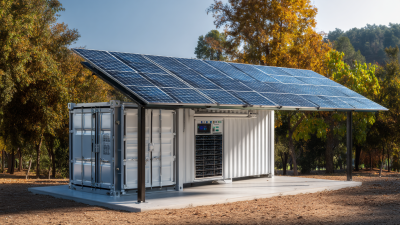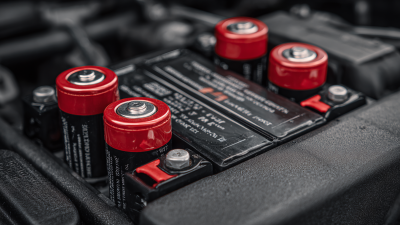Exploring the Future of Renewable Energy with Innovative Battery Store Solutions
As the world grapples with the urgent need for sustainable energy solutions, the role of innovative battery store technologies becomes increasingly critical. According to the International Energy Agency (IEA), global renewable energy capacities are expected to reach 4,500 GW by 2023, indicating a significant shift towards cleaner energy sources. However, the intermittent nature of renewable energy, such as solar and wind, necessitates efficient storage systems to maximize their potential. A recent report by BloombergNEF highlights that battery storage installations are projected to grow nearly six-fold by 2030, driven by declining costs and advancements in technology. This transformation in energy storage is crucial to alleviating the pressures on electrical grids and ensuring a reliable power supply, thus paving the way for a more resilient and sustainable energy future. As we explore the future of renewable energy, understanding the innovations behind battery store solutions will be pivotal in harnessing the full capabilities of our renewable resources.

The Role of Innovative Battery Storage in Advancing Renewable Energy Adoption
Innovative battery storage solutions are crucial for advancing the adoption of renewable energy, as they address the intermittent nature of sources like solar and wind. By enabling energy to be stored during peak production periods and released during high demand, these technologies enhance grid stability and reliability. The outdoor energy storage market is projected to reach $5.64 billion by 2031, growing at a compound annual growth rate (CAGR) of 14.2% from 2024. This growth indicates a robust demand for efficient energy management systems that can seamlessly integrate with renewable sources.
Moreover, hydrogen storage presents a transformative opportunity within the renewable energy landscape. Its ability to store energy over long periods and transport it across regions aligns perfectly with the goals of achieving carbon neutrality. By investing in hydrogen energy technologies, we can effectively tackle the challenges posed by seasonal energy fluctuations and enhance our overall energy security. The ongoing development of innovative battery storage and hydrogen solutions is not just a technological advancement; it is a strategic move towards a sustainable energy future.
Technological Advancements in Battery Storage: Key Innovations Shaping the Future
Innovative battery storage solutions are poised to revolutionize the renewable energy sector by addressing one of its most significant challenges: energy intermittency. As the reliance on solar and wind energy increases, advanced battery technologies are being developed to store excess energy generated during peak production periods. Solid-state batteries, for instance, offer higher energy density and enhanced safety compared to traditional lithium-ion batteries. Their development could lead to more efficient energy storage methods, enabling homes and businesses to harness renewable energy more effectively.
Moreover, the integration of artificial intelligence and machine learning into battery management systems is transforming how we optimize energy use. These technologies enable smarter charging and discharging cycles based on consumption patterns and grid demands, optimizing the longevity of battery systems. Additionally, innovative materials, such as graphene and lithium-sulfur, are being researched to improve battery performance and reduce costs, making renewable energy sources more accessible to a broader audience. As these advancements continue to evolve, they will play a critical role in shaping a sustainable energy future.
Exploring the Future of Renewable Energy with Innovative Battery Store Solutions
Economic Impacts of Battery Storage Solutions on Renewable Energy Markets
The integration of innovative battery storage solutions is set to transform the renewable energy market significantly. By offering efficient ways to store energy generated from renewable sources like solar and wind, these solutions mitigate the intermittency issues that often plague these technologies. As a result, energy producers can stabilize their output, ensuring a more reliable supply to the grid. This reliability not only enhances consumer confidence but also encourages long-term investments in renewable infrastructures.
Economically, the impact of battery storage solutions extends beyond just enhancing energy reliability. They create new market opportunities by enabling a more dynamic pricing structure that reflects real-time supply and demand. Additionally, improved storage capabilities can reduce the reliance on fossil fuels during peak demand times, leading to lower operational costs for utilities and consumers alike. Over time, this shift toward sustainable energy practices supported by battery technologies can catalyze job creation in manufacturing, installation, and maintenance sectors, underpinning a more stable and robust renewable energy economy.
Exploring the Future of Renewable Energy with Innovative Battery Store Solutions - Economic Impacts of Battery Storage Solutions on Renewable Energy Markets
| Region | Market Size (2023, Billion USD) | Projected Growth Rate (2024-2030, %) | Battery Storage Capacity (GWh) | Renewable Energy Share (%) |
|---|---|---|---|---|
| North America | 25.4 | 11.5 | 40 | 29 |
| Europe | 30.1 | 8.8 | 50 | 35 |
| Asia-Pacific | 45.7 | 15.0 | 70 | 40 |
| Latin America | 10.2 | 12.3 | 15 | 25 |
| Middle East & Africa | 5.5 | 7.0 | 8 | 20 |
Challenges and Solutions in Integrating Battery Storage with Renewable Energy Sources
The integration of battery storage with renewable energy sources presents both significant challenges and innovative solutions. One of the primary difficulties lies in the intermittency of renewable resources such as solar and wind, which can lead to fluctuations in energy supply. Effective energy storage systems (ESS) are crucial in addressing these variations, ensuring a stable and reliable power supply. Recent advancements in lithium-ion battery technology and other storage mechanisms are pivotal in enhancing capacity and efficiency, thus enabling more extensive use of renewable energy in existing grids.
Moreover, the integration of electric vehicles (EVs) into this ecosystem showcases an innovative approach to energy management. Vehicle-to-grid (V2G) technology allows EVs to interact with the grid, providing necessary support by feeding energy back during peak demand times when renewable generation is low. This not only stabilizes the grid but also maximizes the utilization of renewable resources, leading to a more resilient and sustainable energy infrastructure. As various sectors collaborate to innovate battery storage solutions, the future of renewable energy integration looks promising.

Future Trends: The Evolution of Battery Technology in the Renewable Energy Sector
As we look towards the future of renewable energy, the evolution of battery technology plays a pivotal role in driving the sector forward. Recent reports indicate that demand for renewable energy is expected to rise significantly, with projections suggesting that global energy demand will increase substantially by 2025. To harness this growth effectively, innovative energy storage solutions, particularly advanced battery technologies, are crucial. The emergence of solid-state sodium-ion batteries marks a significant breakthrough, promising higher energy densities and improved safety profiles compared to traditional lithium-ion variants.
Moreover, the advancements in photovoltaic technology further reinforce the need for efficient battery systems to ensure the stability and reliability of power supply. With the integration of microgrid systems and vehicle-to-grid technology, the landscape of energy consumption is rapidly changing. Recent studies suggest that these innovations could enhance the stability of renewable energy sources, reducing reliance on fossil fuels and fostering sustainability. The convergence of these technologies indicates a significant shift towards a diversified energy ecosystem, with batteries at the forefront of this transformative journey.

Related Posts
-

Revolutionizing Energy Storage: The Future of Battery Solutions for Sustainable Living
-

7 Secrets to Finding the Best Battery Shop for Your Needs
-

How to Maximize the Lifespan of Your Deep Cycle Batteries
-

How to Extend the Lifespan of Your Car Batteries: Essential Tips and Tricks
-

Exploring Battery Service Innovations at the 138th Canton Fair 2025: Industry Trends and Insights
-

Battery Power Innovations at the 138th Canton Fair 2025 Enhancing Industry Data Insights
